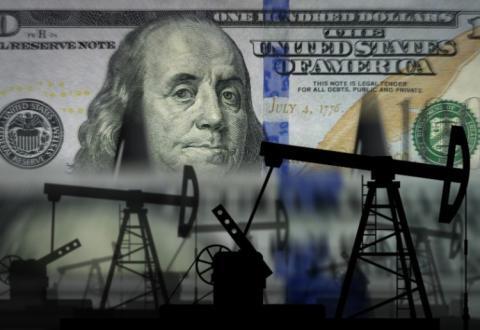Steve Bull's Blog, page 167
November 9, 2022
The decoupling canard won’t die…
aka, ‘Green Growth is an oxymoron’! I keep coming across people contending that decoupling will allow continued economic expansion, whilst reducing emissions. I put together this summary of rebuttals:
This is a great starting observation from Tim Morgan at Surplus energy economics:
“At the same time, we should dismiss the idea that we can somehow “decouple” the economy from energy. Fortunately, a quite superb recent report from the European Environmental Bureau (EEB) has debunked the concept of “decoupling” so comprehensively that we can defer detailed consideration to a later discussion.
“Our finding is clear”, the EEB report concludes – “the decoupling literature is a haystack without a needle”.
There – political leaders please note – goes your cherished ambition to deliver “sustainable growth”. ‘Sustainable’ is something to which we can and must aspire. But “growth” is not.”
More: https://surplusenergyeconomics.wordpress.com/2019/09/02/155-the-art-of-dark-sky-thinking/
Here’s the direct link to the EEB’s comprehensive debunking of the decoupling canard… https://eeb.org/decoupling-debunked/ summarised as:
Although decoupling is useful and necessary, and has occurred at certain times and places, ‘green growth’ cannot reduce resource use on anywhere near the scale required to deal with global environmental breakdown and to keep global warming below the target of 1.5°C above pre-industrial levels, the threshold established as part of the Paris Agreement.
This is the conclusion of ‘Decoupling debunked: Evidence and arguments against green growth as a sole strategy for sustainability’. Published by the European Environmental Bureau (EEB), the report reviews the empirical evidence and theoretical literature to assess the validity of the decoupling hypothesis.
The report, whose lead author is Timothée Parrique of the Centre for Studies and Research in International Development (CERDI), finds that there is no empirical evidence supporting the existence of an absolute, permanent, global, substantial and sufficiently rapid decoupling of economic growth from environmental pressures. Absolute decoupling is also highly unlikely to happen in the future, the report concludes.
…click on the above link to read the rest…
Oil Prices Are Primed To Spike This Winter
Less than a month from now, an embargo on seaborne Russian crude oil exports to the European Union will come into effect. As a result, global oil supply is set to tighten considerably as Russia is the biggest oil and fuels exporter in the world. And the market is preparing.
Hedge funds once again like oil, and are buying it on the futures market in considerable volumes, according to Reuters’ John Kemp. Last week, the buying reached 22 million barrels of Brent crude and 15 million barrels of West Texas Intermediate.
India is buying Russian crude at a discount, so it is buying a lot: its share of Middle Eastern oil imports fell to the lowest in 19 months in September, according to new data. Russia overtook Saudi Arabia as India’s number-two supplier after Iraq.
China is also buying Russian oil and not giving any indications it’s going to stop when the embargo enters into effect. The same is true of the G7 price cap for Russian crude that should also be coming into effect in a few weeks. China has already stated this will not change its current oil-buying habits.
Yet, with an EU embargo and a G7 price cap, what will almost certainly happen by the end of the year is that oil will become more expensive than it is now. Perhaps more worryingly, fuels – especially diesel…
…click on the above link to read the rest…
Tucker Carlson: The U.S. is about to run out of diesel fuel
November 8, 2022
World Dollar Hegemony Is Ending (and That May Be a Good Thing)

The end of world dollar hegemony is coming and hardly anyone in government is taking notice or even understands what this means. Since the Bretton Woods Conference in 1944, the dollar has been the only currency accepted throughout the world for settlement of international trade accounts among nations.
Prior to 1944, physical gold was used for international settlement. When an exporter in country A sold goods to an importer in country B, country B would pay with its own currency. But country A would have no interest in allowing country B’s currency to build up in its vaults beyond an amount required to settle its own importers’ needs. Thus, country A would demand that country B redeem its own currency in gold. Sometimes country B would ship physical gold to country A. Or perhaps gold held in safekeeping in a third country would be designated as now belonging to country A, a book entry transaction that is more convenient than physical movement.
The Bretton Woods Agreement and Its DemiseThe Bretton Woods Agreement added the dollar as tantamount to physical gold at $35 per ounce. The reason was simple: at the end of World War II the United States had accumulated a preponderance of gold, due primarily to its role as the “arsenal of democracy.” Thus, central banks could exchange dollars for settlement rather than moving or redesignating the ownership of physical gold. The weakness of this system was that the world had to trust the USA not to create more dollars than it could redeem for gold at $35 per ounce. But central banks always had the option to demand physical gold from the USA and hence ensure that their trust in the measure of $35 per ounce was fully supported.
…click on the above link to read the rest…
The Shortages Are Coming

Do you remember in early 2020 when they told us that the shortages that we were experiencing would just be temporary? Of course some of them were, but then more shortages just kept on erupting. That wasn’t supposed to happen, and now it appears that our supply chain problems could potentially get a whole lot worse. In just a few short months, we will be three years away from the beginning of the pandemic in the United States. But instead of a “return to normal”, more shortages are on the way. And in some cases, they could even be life threatening.
Let me give you an example. We need Amoxicillin to treat some of the most common infections that our children experience. Unfortunately, the FDA is warning us that we are now facing a very serious shortage of Amoxicillin…
Ear infections and strep throat.
Both are common childhood illnesses, for which the go-to prescription is in short supply, according to a recent nationwide alert from the U.S. Food and Drug Administration.
The warning specifically involves the powder, which pharmacists use to mix liquid Amoxicillin for childhood infections.
This is a really big deal.
According to one recent survey, close to two-thirds of all pharmacies in the nation are having difficulty getting Amoxicillin right now, and the national shortage of Adderall is even worse…
Nearly 66% of pharmacies are having challenges obtaining amoxicillin, according to a new National Community Pharmacists Association (NCPA) survey of 8000 pharmacy owners and managers, whereas 89% are realizing a shortage of Adderall.
Of course we are dealing with lots of other drug shortages at this moment as well.
In fact, according to the official FDA drug shortage list there are nationwide shortages of a whopping 183 different drugs in the United States right now.
We truly are in unprecedented territory.
Up in Canada, things are even worse.
…click on the above link to read the rest…
How much oil remains for the world to produce? Comparing assessment methods, and separating fact from fiction
Abstract
This paper assesses how much oil remains to be produced, and whether this poses a significant constraint to global development. We describe the different categories of oil and related liquid fuels, and show that public-domain by-country and global proved (1P) oil reserves data, such as from the EIA or BP Statistical Review, are very misleading and should not be used. Better data are oil consultancy proved-plus-probable (2P) reserves. These data are generally backdated, i.e. with later changes in a field’s estimated volume being attributed to the date of field discovery. Even some of these data, we suggest, need reduction by some 300 Gb for probable overstatement of Middle East OPEC reserves, and likewise by 100 Gb for overstatement of FSU reserves. The statistic that best assesses ‘how much oil is left to produce’ is a region’s estimated ultimately recoverable resource (URR) for each of its various categories of oil, from which production to-date needs to be subtracted. We use Hubbert linearization to estimate the global URR for four aggregate classes of oil, and show that these range from 2500 Gb for conventional oil to 5000 Gb for ‘all-liquids’. Subtracting oil produced to-date gives estimates of global reserves of conventional oil at about half the EIA estimate. We then use our estimated URR values, combined with the observation that oil production in a region usually reaches one or more maxima when roughly half its URR has been produced, to forecast the expected dates of global resource-limited production maxima of these classes of oil. These dates range from 2019 (i.e., already past) for conventional oil to around 2040 for ‘all-liquids’. These oil production maxima are likely to have significant economic, political and sustainability consequences…
…click on the above link to read the rest…How to Beat Propaganda: the Grokking Strategy
 We CAN beat propaganda, but it takes some effort to avoid falling prey to the simple, yet effective, methods that the powers that be (PTB) use to control us. You need first of all to understand that there is no such thing as an “authoritative source.” All sources can be wrong, and many are there to trick you into believing that something is true when it is not. So, you need to listen to everybody and trust nobody. In this way, you can “grok” your information and not be grokked by the PTB.
We CAN beat propaganda, but it takes some effort to avoid falling prey to the simple, yet effective, methods that the powers that be (PTB) use to control us. You need first of all to understand that there is no such thing as an “authoritative source.” All sources can be wrong, and many are there to trick you into believing that something is true when it is not. So, you need to listen to everybody and trust nobody. In this way, you can “grok” your information and not be grokked by the PTB.I remember how, as a young scientist, I spent long hours at night perusing scientific journals in my department’s library, at the Lawrence Berkeley Laboratory. The administrators wisely kept the library open all night for us, students and postdocs, to nibble at the treasure of knowledge stored there. It was the equivalent of what we do today when “surfing the Web”, it was just slower and more laborious. But it was a great experience: I soon learned that not all the articles found in scientific journals were trustworthy, nor were the scientists who had published them. When I started my career, frauds and lies in science were still rare, but even in “high-level” scientific journals, there were plenty of evident mistakes, unjustified assumptions, sloppy work, or, simply, irrelevant babbling.
It was a different story when I was a student. As a student, you are supposed to be “trained.” The term comes from the Latin “trahere, ‘to pull.’ It implies that your teachers can force you to learn whatever they think you must learn. So, you can pass exams in college without having understood anything of what you regurgitate to your examiners. But things change completely when you become a professional……click on the above link to read the rest…
The Unintended Consequences of Unintended Consequences
Decades of central bank distortions and regulatory / market-share capture by cartels and monopolies have completely gutted “markets,” destroying their self-correcting dynamics.
Unintended consequences introduce unexpected problems that may not have easy solutions. An entirely different set of problems are unleashed as unintended consequences have their own unintended consequences. This is the problem with complex emergent systems such as economies, societies and global supply chains: the system’s feedback, leverage points and phase-change thresholds are not necessarily visible or predictable, yet these dynamics have the potential to cascade small failures into systemic collapse.
The unintended consequences of unintended consequences are called second-order effects: consequences have their own consequences.
So for example, you juice your economy with massive stimulus after a lockdown that upended consumers and global supply chains, crushing both demand and supply, and suddenly you have rip-roaring inflation as demand comes back while supply chains remain tangled.
Shifting critical industrial production to frenemies so corporations could maximize profits while reducing the quality of goods and services seemed like a good idea until the potential costs of that dependence on frenemies become apparent.
Assuming oil and natural gas would always be in abundance made sense when they were abundant, but geopolitical forces kicked that assumption into the gutter. All the reassuring economic stories we told ourselves–energy is only 3.5% of the economy and the household spending budget, so cost really doesn’t matter–fall off the cliff when availability and supply become the paramount issues setting price.
That 3.5% loses meaning when there’s not enough to supply demand and somebody loses the game of musical chairs.
Then there’s the fantasy that monetary policy imposed by central banks control inflation. The inconvenient reality is central bank monetary policy is akin to building sand castles on the beach: when the tide is ebbing, the castles look magnificent. When the tide is rising, the sand castles are quickly washed away.
…click on the above link to read the rest…
Climate change threatening ‘things Americans value most,’ U.S. report says
Climate change is unleashing “far-reaching and worsening” calamities in every region of the United States, and the economic and human toll will only increase unless humans move faster to slow the planet’s warming, according to a sprawling new federal report released Monday.
“The things Americans value most are at risk,” the National Climate Assessment authors, who represent a broad range of federal agencies, write in the draft report. “Many of the harmful impacts that people across the country are already experiencing will worsen as warming increases, and new risks will emerge.”
The congressionally mandated assessment, last issued under the Trump administration in 2018, comes as world leaders gather this week in Egypt for a U.N. Climate Change Conference, known as COP27, aimed at prodding nations to tackle the problem with more urgency.
The report’s authors detail how climate-fueled disasters are becoming more costly and more common, and how the science is more clear than ever that rapid cuts in greenhouse gas emissions are needed to slow the profound changes that are underway.
Humans have pushed the climate into ‘unprecedented’ territory, landmark U.N. report finds
The draft report, which probably will be finalized next year after a period of public comment and peer review, finds that in a world that has already warmed 1.1 degrees Celsius (2 degrees Fahrenheit) above preindustrial levels, the situation in the United States is even more extreme.
“Over the past 50 years, the U.S. has warmed 68 percent faster than the planet as a whole,” the report finds, noting that the change reflects a broader global pattern in which land areas warm faster than the ocean, and higher latitudes warm more rapidly than lower latitudes.
…click on the above link to read the rest…
Big agriculture warns farming must change or risk ‘destroying the planet’
Food companies and governments must come together immediately to change the world’s agricultural practices or risk “destroying the planet”, according to the sponsors of a report by some of the largest food and farming businesses released on Thursday.
 Photograph: Jeff McIntosh/AP© Provided by The Guardian
Photograph: Jeff McIntosh/AP© Provided by The GuardianThe report, from a task force within the Sustainable Markets Initiative (SMI), a network of global CEOs focused on climate issues established by King Charles III, is being released days before the start of the United Nation’s Cop27 climate summit in Egypt.
The best men’s shoes for walking and standing all day
AdRelated: Waterlogged wheat, rotting oranges: five crops devastated by a year of extreme weather
Many of the world’s largest food and agricultural businesses have championed sustainable agricultural practices in recent years. Regenerative farming practices, which prioritize cutting greenhouse gas emissions, soil health and water conservation, now cover 15% of croplands.
But the pace of change has been “far too slow”, the report finds, and must triple by 2030 for the world to have any chance of keeping temperature rises under 1.5C, a level that if breached, scientists argue, will unleash even more devastating climate change on the planet.
The report is signed by Bayer, Mars, McCain Foods, McDonald’s, Mondelez, Olam, PepsiCo, Waitrose and others. They represent a potent political and corporate force, impacting the food supply chain around the world. They are also, according to critics, some of those most responsible for climate mismanagement with one calling the report “smoke and mirrors” and unlikely to address the real crisis.
Food production is responsible for a third of all planet-heating gases emitted by human activity and a number of the signatories have been accused of environmental misdeeds and “greenwashing”…
…click on the above link to read the rest…



